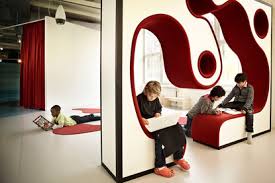Like many of my colleagues I have been witnessing the rise of the Innovation Tour. These tours provide opportunities for schools to showcase their teaching and learning spaces and allow visiting staff from a wide variety of schools to view innovative practices in action. Tourists have gone far and wide in search of the innovative practice. I am not suggesting that this is not a valuable pursuit, educators have been visiting other sites and borrowing best practice since well before I entered the profession. I am not sure though that every tourist is looking at the pedagogy behind the innovation. The question that has to be answered after each tour is, how has this environment improved the educational experience of students?

It’s the quality of the teaching not the furniture that makes the difference
My first year at school was in an innovative classroom. Back in 1975 I was enrolled in a “Family Group”. The idea was that students would become involved in interest based projects in a K-6 classroom. There was no one restrictive classroom rather a block of rooms that students could choose to work in. The furniture ranged from traditional desks to bean bags, to lounge chairs to cushions on the floor. There were no bells and no strict routines. Students chose to participate in more regular school work or participate in passion based projects. As a 5 year old this was Nirvana. At the end of the first year I had learnt three important lessons. The first, I discovered on an overnight excursion, was that I was still small enough to sleep in a baby’s cot, the second that if you put your hand into a pot of molten wax when you withdrew it and it cooled down you could make a wax glove. The final lesson, that a cow pat made a great soccer ball when you were in a paddock. All of these lessons obviously left an impression as I am able to recall them in 2015, however none had much relevance to life after school. At age 6 I could neither read nor write, I had no real experience of co-operation or collaboration as I was in a class with a range of ages all of whom chose their own learning experiences. There was little or no systematic instruction, no way of ensuring I had a core set of skills that would allow me to access the curriculum and no real plan to see this improve. I had however, survived an innovative classroom. In 1976 I enrolled in a mainstream NSW Public School.
Innovation by its very definition requires change, transformation, reorganisation and restructuring. Innovation in education is more than semi-circle tables, ottomans and a chair in the shape of large hand. It is about challenging pedagogy and designing ways of engaging students that make learning relevant. In my view innovation is placing a lens over the concept of having mastery over content knowledge and asking is it more desirable to be able to access and interpret such knowledge? Our students still need systematic and explicit instruction, they need to be shown how to engage in new ways of learning. We still need to provide our students with the core skills needed to be able to access and utilise the resources at their disposal. Many of us look at new ways of learning through adult eyes and bring our own interpretation. We still have a restricted view on what education is. Talking with our students about what they know, what they need to know and how they are going to get there, places students at the centre of their learning. I believe that this has always been at the heart of quality teaching practice, we are now just labelling it with more specific terminology i.e. success criteria, learning intentions, student goals etc. Innovation is about changing your thinking as a teacher. It’s about knowing your students and knowing what works for them. It’s about daring to think outside the box and challenging yourself to look at things differently. It’s certainly not a disjointed free for all.
Educational innovation is seeing the changing of learning spaces. Schools and systems are moving away from facility standard designs and looking at functional approaches to designing spaces. I would encourage any school heading down this path to think deeply about why they are changing their learning spaces. What is the reason for the change? How will it enhance students’ learning? What is the motivation for innovation? What are you trying to achieve? What evidence do you have to demonstrate that this approach is making a difference for your students? The physical learning environment is just one element that can impact on a students learning. Your understanding and reasoning of how this will enhance learning opportunities for your students should be the main focus of any re-design of a learning space.
Innovation is about transforming education so students engage in and with it rather than endure it. It’s about relating it to real world experiences and preparing students to be problem solvers, to be critical thinkers and discerning users of information. Innovation certainly has its place. Our curriculum is expanding as is the way our students will have to interact in their world as they leave school. Students are certainly required to have a much broader skill set. The time of working hard at school until you transition into the workforce have long gone. There are vast numbers of graduates flooding markets creating increased competition for employment. Innovation in education is about preparing our students for this environment. Our students need to be able to think creatively to solve problems, they need to be flexible and adaptable. They need to be able to transfer skills across multiple contexts. This is what I am looking for on an innovation tour not a splash of colour and a funky piece of furniture.

Hello Scott, I agree it is important to look at the reasons for changing the form of the learning space. On 2 recent “IKEA education trips” in Alberta and NZ what i have noticed thta it is more important to look at what is happening in the learning space and how that learning is created, supported and understood. You can’t beat quality teaching and the challenge for many is to engage all students and their famiies to have concern for student learning.
I’m curious about the comment that “innovation is about changing your thinking as a teacher” – i agree mindsets are vital and many teachers will benefit from moving from a fixed to a growth inset. It will explore that comment more – my reaction is that it’s what the teacher does with those thoughts that needs to be innovative.
A thoughtful article – thanks sharing your ideas
LikeLike
Hi Peter, thanks for your thoughts. I believe that challenging your thinking, reflecting, refining and refocusing are at the centre of innovation otherwise you are just maintaining the status quo. I have witnessed classrooms where the only innovation is the furniture, the teaching has not changed the students just have a different place to sit. We all need to challenge our thinking to improve. There is a great sporting analogy of a team striving to emulate the world champions. By the the time the team got there the world champs had moved on because they kept challenging what they did to find ways to improve. I hope the article has given food for thought and at the very least has people asking questions about their teaching practice.
LikeLike